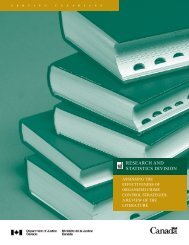National Threat Assessment 2008. Organised Crime - Politie
National Threat Assessment 2008. Organised Crime - Politie
National Threat Assessment 2008. Organised Crime - Politie
Create successful ePaper yourself
Turn your PDF publications into a flip-book with our unique Google optimized e-Paper software.
Alerts<br />
6<br />
6.1 Introduction<br />
The objective of the <strong>National</strong> <strong>Threat</strong> <strong>Assessment</strong> is not only to contribute to<br />
setting priorities for the fight against organised crime. It should also provide<br />
information about other matters that may be important in this context in the<br />
future and that require further gathering of information (alerts, section 1.3).<br />
In this chapter several of these matters are discussed. These are mainly new or<br />
notable phenomena that can be considered ‘additional catches’. This means<br />
that the investigation was not from the outset set up to obtain an insight into<br />
these criminal phenomena, which in turn means that insufficient information<br />
is available to determine whether there is a threat or not.<br />
In previous chapters criminal phenomena were mainly described from the<br />
perspective of the criminal activity such as human trafficking and the growing<br />
of Nederweed. Also the perspective of the criminal modus operandi is used,<br />
providing an insight into the use of violence or corruption, for example.<br />
Up to this point much less attention has been paid to the third perspective:<br />
the involvement of a certain category of criminal organisations.<br />
A number of groups turned up in the source material for this NTA rather regularly<br />
and, as a result, they were more and more noticeable as the research continued.<br />
These are criminal organisations whose members belong to population groups<br />
that stand out because of their history and culture. This background may partly<br />
explain certain involvement in criminal activities. This chapter analyses the<br />
criminal activities of three specific categories of criminal organisation, namely<br />
criminal caravan camp residents, criminal Roma and West African criminal<br />
networks. This discussion does not address the question of whether members of<br />
these population groups are more involved in criminal activities than other<br />
population groups. We would also like to emphasise that it is not the intention to<br />
stigmatise an entire group. However, it is important to take into account the<br />
specific culture and networks of these groups during investigations.<br />
There are a few other phenomena that are also worth mentioning. These<br />
other phenomena will be addressed in the remaining sections, which cover<br />
the criminal liaisons that move to the Netherlands, the cocaine washing facilities<br />
found in the Netherlands, the use of the Internet by criminal organisations and<br />
the role of smaller airports in smuggling.<br />
chapter 6 – alerts<br />
217








